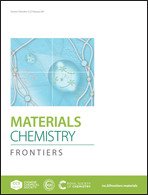Synergy strategy to the flexible alkyl and chloride side-chain engineered quinoxaline-based D–A conjugated polymers for efficient non-fullerene polymer solar cells†
Abstract
With the meteoric progress on acceptor materials for non-fullerene polymer solar cells (NF-PSCs), exploring efficient and matched copolymer donor materials has become a key issue. Herein, to achieve a balance among open-circuit voltage (VOC), short-circuit current density (JSC) and fill factor (FF), we have developed two medium band-gap (MBG) donor–acceptor (D–A) copolymers, namely, PBDTTS-TClQx and PBDTTS-TClSQx, by combining chlorine atoms and flexible alkyl (R) or alkylthio (SR) side-chains engineered quinoxaline (Qx) as the acceptor unit, as well as based on a well-known alkylthio-thienyl substituted benzodithiophene (BDTTS) donor unit. These copolymers were successfully synthesized and finally facilely employed as photovoltaic donor materials for NF-PSCs. After blending with the MeIC acceptor, the PBDTTS-TClQx:MeIC blend film exhibited more balanced electron/hole mobility (μh/μe), better efficient exciton dissociation and nice morphology in comparison with the PBDTTS-TClSQx:MeIC blend film. Encouragingly, chlorination and appropriate side-chains engineering Qx can result in a higher VOC, thus leading to enhancement in JSC and FF parameters. More excitingly, the PBDTTS-TClQx:MeIC-based PSCs exhibit a higher power conversion efficiency (PCE) of 12.59% higher than that of the device based on the PBDTTS-TClSQx:MeIC blend that had a PCE of 11.10%. The higher performance arises from the enhancement in current density (JSC) of 17.07 mA cm−2 and fill factor (FF) of 77.2%. The impressive FF of up to 77.2% is the highest reported for Qx-type copolymers-based NF solar cells to date. These results disclose that chlorination and suitable flexible side-chains are promising strategies to improve the photovoltaic performance of copolymers.



 Please wait while we load your content...
Please wait while we load your content...